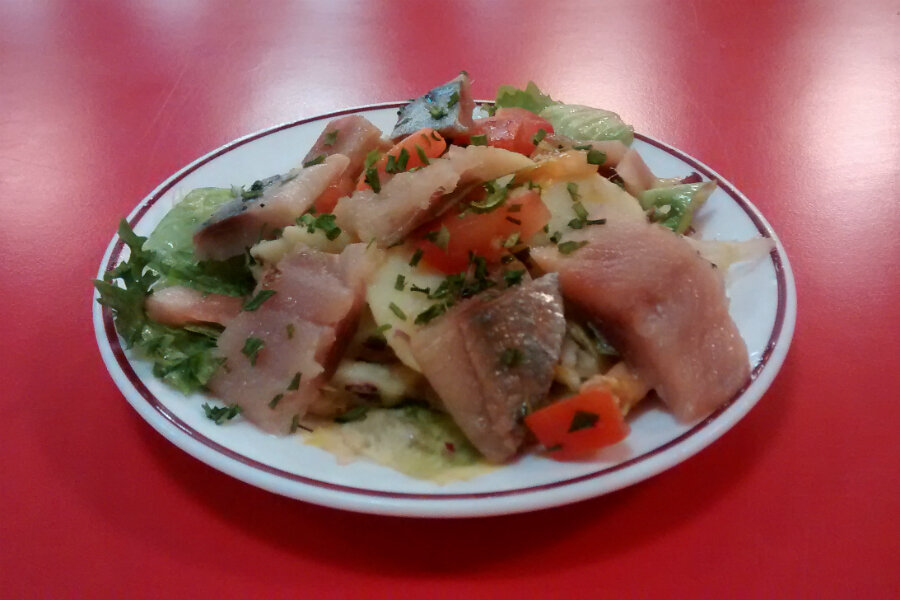Raw herring in the school cafeteria? In France, it's no big deal.
Loading...
| Paris
Dorite Sitbon and I sit down for a test of the four-course meal she’s planned. The first bite – raw herring with perfectly cooked baby potatoes on a bed of greens – is a perfect balance to the taste buds.
If it weren’t for the minuscule chairs we are sitting in, and the high-pitched shrieks of the other diners seated in tables all around us, I might almost think we are in a fine Parisian restaurant. But we’re in a school cafeteria full of hungry kindergartners.
Across the Northern Hemisphere it’s back to class after the summer break, and for many students that means bland cafeteria food that makes their noses turn up, or a cornucopia of chicken nuggets and frozen pizza that turns parents’ noses even higher. But not so in France, where renowned dining is no coincidence: It has long been instilled at the earliest ages.
Cosette Delacroix steps out of the kitchen for a moment, to explain how she sees her role as a cook for a public pre-school. It’s not just about nutrition, she says. It’s about discovery, good manners, and essentially living well. “At home, parents make what kids like,” she says. “Here is where they can try new things.”
This is not to say that school lunches are not exemplary elsewhere, nor that they are perfect here. And French parents do complain that kids refuse to eat what’s served at school (and there is no option to pack lunches). But the role of the school cafeteria, or cantine, sets lofty goals. “Meal time is a privileged moment of discovery and pleasure,” explains the cantine info website of the city of Paris, where 140,000 lunches are served daily.
On this particular day last spring, when I finally managed to get access to the cantine, France was in the throes of the European Championship. Madame Sitbon, who has worked for four decades for the municipal office that oversees the school lunches in our neighborhood, is no great fan of soccer. But she did smell an opportunity: new foods to try on the students. “We didn’t want to propose Spanish or Italian food, but food that is not traditional.” That’s why they celebrated the cuisine of the competing teams from Poland (this day’s menu, which served the raw herring for Grade 1 and up), Russia, or Croatia.
A more typical day is just as exotic, at least for the outsider. The meals are generally always four courses. They include a vegetable starter – because children are more likely to eat vegetables if served when they are hungriest – then a main course and accompaniments, a cheese (or yogurt) course, and dessert. The drink is water. The service is family-style. Even the youngest kids sit for 30 minutes through all the courses.
The staff here cares not just what a meal tastes like, but what it looks like. Sitbon says it is simple. “If you are serving cucumber, that’s green. So we add some red to it,” she says. “The pleasure of the eye is directly linked to the pleasure of the stomach.”
The cantine, where 80 percent of students take their meals, acts as a tool of equality, too. All kids get access to quality food, on a sliding-scale cost that ranges from 13 cents to 7 euros ($0.15 to $7.80) per meal. And a reform is set to take hold in 2018 to centralize planning and purchasing so that menus in poorer neighborhoods match the quality of the wealthier ones, where 75 percent of food served might be organic, compared with 3 percent in the poorest areas. With the reform the city aims to have 50 percent of the food served in each school organic by 2020.
It’s not that the tastes of French kids vary vastly from their counterparts across the world. An informal survey of 5- and 6-year-olds showed the old standards at the top of their favorites: pasta, cheeseburgers, and chocolate cake.
But the French system does seem to make children more prone to try what’s new, or green, or even beet red (beet salad is a constant feature on the school menu).
Sitbon works tirelessly to get them to broaden their horizons. She visits farms to look for fresh produce or top quality yogurt. For today’s dessert, an apricot donut, she double checks that the staff has first heated them up in the oven “so the kids can really taste it,” she says.
And if someone tells her raw herring is too daring, she counters it’s not daring enough. Something came to her as she was eating her salad: wouldn’t raw herring also go well with fresh strawberries?
We give it a try. It is delicious (and looks pretty). She plans to get it on the menu this year.








